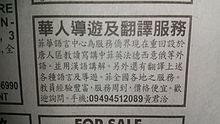Traditional Chinese characters
| Traditional Chinese | |
|---|---|
 | |
| Script type | |
Time period | Since 2nd century AD[1] |
| Direction |
|
| Official script |
|
| Languages | Chinese, Korean (Hanja), Japanese (Kyūjitai) |
| Related scripts | |
Parent systems | Oracle bone script
|
Child systems | |
| ISO 15924 | |
| ISO 15924 | Hant (502), Han (Traditional variant) |
| Traditional Chinese characters | |||||||||||||||
|---|---|---|---|---|---|---|---|---|---|---|---|---|---|---|---|
| Traditional Chinese | 正體字 | ||||||||||||||
| Simplified Chinese | 正体字 | ||||||||||||||
| Literal meaning | Standard form characters | ||||||||||||||
| |||||||||||||||
| Alternative rendering | |||||||||||||||
| Traditional Chinese | 繁體字 | ||||||||||||||
| Simplified Chinese | 繁体字 | ||||||||||||||
| Literal meaning | Complex form characters | ||||||||||||||
| |||||||||||||||

Traditional Chinese characters are one type of standard Chinese character sets of the contemporary written Chinese. The traditional characters had taken shapes since the clerical change and mostly remained in the same structure they took at the introduction of the regular script in the 2nd century.[1] Over the following centuries, traditional characters were regarded as the standard form of printed Chinese characters or literary Chinese throughout the Sinosphere until the middle of the 20th century,[1][3][4] before different script reforms initiated by countries using Chinese characters as a writing system.[3][5][6]
Traditional Chinese characters remain in common use in Taiwan, Hong Kong and Macau, as well as in most overseas Chinese communities outside Southeast Asia;[7] in addition, Hanja in Korean language remains virtually identical to traditional characters, which is still used to a certain extent in South Korea, despite differing standards used among these countries over some variant Chinese characters. In Taiwan, the standardization of traditional characters is stipulated through the promulgation of the Standard Form of National Characters, which is regulated by Taiwan's Ministry of Education. In contrast, simplified Chinese characters are used in Mainland China, Malaysia, and Singapore in official publications.
The debate on traditional and simplified Chinese characters has been a long-running issue among Chinese communities.[8][9] Currently, many Chinese online newspapers allow users to switch between both character sets.[2]
History
The modern shapes of traditional Chinese characters first appeared with the emergence of the clerical script during the Han dynasty and have been more or less stable since the 5th century (during the Southern and Northern dynasties).
The retronym "traditional Chinese" is used to contrast traditional characters with "simplified Chinese characters", a standardized character set introduced in the 1950s by the government of the People's Republic of China on Mainland China.
Modern usage in Chinese-speaking areas
-
The east square of Guangzhou railway station in 1991. Notice the prevalence of traditional Chinese characters as brand logos during that time, including Jianlibao (健力寶), Rejoice (飄柔) and 萬家樂; only Head & Shoulders (海飞丝) printed in simplified. In Mainland China, it is legal to design brand logos in traditional characters, yet by 2020, apart from Jianlibao, the other three have changed to simplified.
Mainland China
Although simplified characters are endorsed by the government of China and taught in schools, there is no prohibition against using traditional characters. Traditional characters are used informally, primarily in handwriting (Chinese calligraphy), but also for inscriptions and religious text.[citation needed] They are often retained in logos or graphics to evoke yesteryear. Nonetheless, the vast majority of media and communications in China use simplified characters.
Hong Kong and Macau
In Hong Kong and Macau, traditional Chinese has been the legal written form since colonial times. In recent years, however, simplified Chinese characters are also used to accommodate Mainland Chinese tourists and immigrants.[10] The use of simplified characters has led to residents being concerned about protecting their local heritage.[11][12]
Taiwan
Taiwan has never adopted simplified characters. The use of simplified characters in government documents and educational settings is discouraged by the government of Taiwan.[13][14][15][16] Nevertheless, simplified characters (簡體字) might be understood by some Taiwanese people, as it could take little effort to learn them. Some writing stroke simplifications have long been in folk handwriting from the ancient time, existing as an informal variant form (俗字) of the traditional characters.[17][18]
Philippines
The Chinese Filipino community continues to be one of the most conservative in Southeast Asia regarding simplification.[citation needed] Although major public universities teach simplified characters, many well-established Chinese schools still use traditional characters. Publications such as the Chinese Commercial News, World News, and United Daily News all use traditional characters. So do some magazines from Hong Kong, such as the Yazhou Zhoukan. On the other hand, the Philippine Chinese Daily uses simplified characters.
DVD subtitles for film or television mostly use traditional characters, that subtitling being influenced by Taiwanese usage and by both countries being within the same DVD region, 3.[citation needed]

United States
Having immigrated to the United States during the second half of the 19th century, well before the institution of simplified characters, Chinese Americans have long used traditional characters. Therefore, US public notices and signage in Chinese are generally in traditional Chinese.[19]
Nomenclature
Traditional Chinese characters are known by different names within the Chinese-speaking world. The government of Taiwan officially calls traditional Chinese characters standard characters or orthodox characters (traditional Chinese: 正體字; simplified Chinese: 正体字; pinyin: zhèngtǐzì; Zhuyin Fuhao: ㄓㄥˋ ㄊㄧˇ ㄗˋ).[20] However, the same term is used outside Taiwan to distinguish standard, simplified, and traditional characters from variant and idiomatic characters.[21]
In contrast, users of traditional characters outside Taiwan—such as those in Hong Kong, Macau, and overseas Chinese communities, and also users of simplified Chinese characters—call the traditional characters complex characters (traditional Chinese: 繁體字; simplified Chinese: 繁体字; pinyin: fántǐzì; Zhuyin Fuhao: ㄈㄢˊ ㄊㄧˇ ㄗˋ), old characters (Chinese: 老字; pinyin: lǎozì; Zhuyin Fuhao: ㄌㄠˇ ㄗˋ), or full Chinese characters (traditional Chinese: 全體字; simplified Chinese: 全体字; pinyin: quántǐ zì; Zhuyin Fuhao: ㄑㄩㄢˊ ㄊㄧˇ ㄗˋ) to distinguish them from simplified Chinese characters.
Some users of traditional characters argue that traditional characters are the original form of Chinese characters and cannot be called "complex". Similarly, they argue that simplified characters cannot be called "standard" because they are not used in all Chinese-speaking regions. Conversely, supporters of simplified Chinese characters object to the description of traditional characters as "standard", since they view the new simplified characters as the contemporary standard used by the vast majority of Chinese speakers. They also point out that traditional characters are not truly traditional, as many Chinese characters have been made more elaborate over time.[22]
Some people refer to traditional characters as simply proper characters (Chinese: 正字; pinyin: zhèngzì; Zhuyin Fuhao: ㄓㄥˋㄗˋ or Chinese: 正寫; pinyin: zhèngxiě; Zhuyin Fuhao: ㄓㄥˋㄒㄧㄝˇ ) and to simplified characters as "simplified-stroke characters" (traditional Chinese: 簡筆字; simplified Chinese: 简笔字; pinyin: jiǎnbǐzì; Zhuyin Fuhao: ㄐㄧㄢˇㄅㄧˇㄗˋ) or "reduced-stroke characters" (traditional Chinese: 減筆字; simplified Chinese: 减笔字; pinyin: jiǎnbǐzì; Zhuyin Fuhao: ㄐㄧㄢˇㄅㄧˇㄗˋ) (simplified- and reduced- are actually homophones in Mandarin Chinese, both pronounced jiǎn; ㄐㄧㄢˇ ).
Printed text
When printing text, people in mainland China and Singapore use the simplified system. In writing, most people use informal, sometimes personal, simplifications. In most cases, an alternative character (異體字) will be used in place of one with more strokes, such as 体 for 體. In the old days,[when?], there were two main uses for alternative characters. First, alternative characters were used to name an important person in less formal contexts, reserving traditional characters for use in formal contexts as a sign of respect, an instance of what is called "offence-avoidance" (避諱) in Chinese. Secondly, alternative characters were used when the same characters were repeated in context to show that the repetition was intentional rather than a mistake (筆誤).
Computer encoding and fonts
In the past, traditional Chinese was most often rendered using the Big5 character encoding scheme, a scheme that favors traditional Chinese. However, Unicode, which gives equal weight to both simplified and traditional Chinese characters, has become increasingly popular as a rendering method. There are various IMEs (Input Method Editors) available to input Chinese characters. There are still many Unicode characters that cannot be written using most IMEs, one example being the character used in the Shanghainese dialect instead of 嗎, which is U+20C8E 𠲎 (伐 with a 口 radical).[citation needed]
In font filenames and descriptions, the acronym TC is used to signify the use of traditional Chinese characters to differentiate fonts that use SC for Simplified Chinese characters.[23]
Web pages
The World Wide Web Consortium recommends the use of the language tag zh-Hant as a language attribute and Content-Language value to specify web-page content in traditional Chinese.[24]
Usage in other languages
In Japanese, kyūjitai is the now-obsolete, non-simplified form of simplified (shinjitai) Jōyō kanji. These non-simplified characters are mostly congruent with the traditional characters in Chinese, save for a few minor regional graphical differences. Furthermore, characters that are not included in the Jōyō list are generally recommended to be printed in their original non-simplified forms, save for a few exceptions.
In Korean, traditional Chinese characters are identical with Hanja (now almost completely replaced by Hangul for general use in most cases, but nonetheless unchanged from Chinese except for some Korean-made Hanja).
Traditional Chinese characters are also used by non-Chinese ethnic groups, especially the Maniq people—of southern Yala Province of Thailand and northeastern Kedah state of Malaysia—for writing the Kensiu language.[25][26]
See also
- Simplified Chinese characters
- Debate on traditional and simplified Chinese characters
- Chữ Nôm
- Hanja
- Kaishu
- Kanji
- Kyūjitai (旧字体 or 舊字體 – Japanese traditional characters)
- Multiple association of converting Simplified Chinese to Traditional Chinese
References
- ^ a b c Wei, Bi (2014). "The Origin and Evolvement of Chinese Characters" (PDF). Gdańskie Studia Azji Wschodniej. 5: 33–44. Retrieved 30 March 2021.
- ^ a b Lin, Youshun 林友順 (June 2009). "Dà mǎhuá shè yóuzǒu yú jiǎn fánzhī jiān" 大馬華社遊走於簡繁之間 [The Malaysian Chinese Community Wanders Between Simple and Traditional] (in Chinese). Yazhou Zhoukan. Retrieved 30 March 2021.
- ^ a b "Why Use CJKV Dict?". CJKV Dict. Retrieved 30 March 2021.
- ^ Kornicki, P. F. (2011). "A Transnational Approach to East Asian Book History". In Chakravorty, Swapan; Gupta, Abhijit (eds.). New Word Order: Transnational Themes in Book History. Worldview Publications. pp. 65–79. ISBN 978-81-920651-1-3.
- ^ Pae, H. K. (2020). "Chinese, Japanese, and Korean Writing Systems: All East-Asian but Different Scripts". Script Effects as the Hidden Drive of the Mind, Cognition, and Culture. Literacy Studies (Perspectives from Cognitive Neurosciences, Linguistics, Psychology and Education), vol 21. Vol. 21. Cham: Springer. pp. 71–105. doi:10.1007/978-3-030-55152-0_5. ISBN 978-3-030-55151-3. S2CID 234940515.
- ^ Twine, Nanette (1991). Language and the Modern State: The Reform of Written Japanese. Taylor and Francis. ISBN 978-0-415-00990-4.
- ^ Yan, Pu; Yasseri, Taha (May 2016). "Two Roads Diverged: A Semantic Network Analysis of Guanxi on Twitter". arXiv:1605.05139 [physics.soc-ph].
- ^ O'Neill, Mark (8 June 2020). "China Should Restore Traditional Characters-Taiwan Scholar". EJ Insight. Hong Kong Economic Journal. Retrieved 30 March 2021.
- ^ Sui, Cindy (16 June 2011). "Taiwan Deletes Simplified Chinese from Official Sites". BBC News. Retrieved 30 March 2021.
- ^ Li, Hanwen 李翰文 (24 February 2016). "Fēnxī: Zhōngguó yǔ xiānggǎng zhī jiān de 'fán jiǎn máodùn'" 分析:中國與香港之間的「繁簡矛盾」. BBC News (in Chinese). Retrieved 1 July 2018.
- ^ Lai, Ying-kit (17 July 2013). "Hong Kong Actor's Criticism of Simplified Chinese Character Use Stirs up Passions Online". Post Magazine. scmp.com. Retrieved 1 July 2018.
- ^ "Hong Kong TV Station Criticized for Using Simplified Chinese". SINA English. 1 March 2016. Retrieved 1 July 2018.
- ^ Chiang, Evelyn (11 April 2006). "Character Debate Ends up Being Nothing but Hot Air: Traditional Chinese Will Always Be Used in Education, Minister Says". Taiwan News. Archived from the original on 25 May 2021. Retrieved 25 May 2021.
- ^ "Taiwan Rules out Official Use of Simplified Chinese". Taiwan News. Central News Agency. 17 June 2011. Archived from the original on 25 May 2021. Retrieved 25 May 2021.
- ^ "Xiězuò cèyàn" 寫作測驗 [Writing Test]. Guozhong jiaoyu huikao (in Chinese).
若寫作測驗文章中出現簡體字,在評閱過程中可能被視為「錯別字」處理,但寫作測驗的評閱方式,並不會針對單一錯字扣分……然而,當簡體字影響閱讀理解時,文意的完整性亦可能受到影響,故考生應盡量避免書寫簡體字
- ^ "Zhuǎn zhī: Gè xiào bànlǐ kè hòu shètuán, yīng jiǎnshì shòukè jiàoshī zhī jiàocái nèiróng, bìmiǎn yǒu bùfú wǒguó guóqíng huò shǐyòng jiǎntǐzì zhī qíngxíng" 轉知:各校辦理課後社團,應檢視授課教師之教材內容,避免有不符我國國情或使用簡體字之情形. Xin beishi tong rong guomin xiaoxue (in Chinese). 3 June 2020.
- ^ Cheung, Yat-Shing (1992). "Language Variation, Culture, and Society". In Bolton, Kingsley (ed.). Sociolinguistics Today: International Perspectives. Routledge. pp. 211.
- ^ Price, Fiona Swee-Lin (2007). Success with Asian Names: A Practical Guide for Business and Everyday Life. Nicholas Brealey Pub. ISBN 9781857883787 – via Google Books.
- ^ See, for instance, https://www.irs.gov/irm/part22/irm_22-031-001.html Archived 3 March 2016 at the Wayback Machine (Internal Revenue Manual 22.31.1.6.3 – "The standard language for translation is Traditional Chinese."
- ^ 查詢結果. Laws and Regulations Database of The Republic of China. Ministry of Justice (Republic of China). 26 September 2014. Retrieved 7 October 2014.
- ^ Academy of Social Sciences (1978). Modern Chinese Dictionary. Beijing: The Commercial Press.
- ^ Norman, Jerry (1988). Chinese. Cambridge: Cambridge University Press. p. 81.
- ^ "Noto CJK". Google Noto Fonts.
- ^ "Internationalization Best Practices: Specifying Language in XHTML & HTML Content". W3.org. Retrieved 27 May 2009.
- ^ Phaiboon, D. (2005). "Glossary of Aslian Languages: The Northern Aslian Languages of South Thailand" (PDF). Mon–Khmer Studies. 36: 207–224.
- ^ Bishop, N. (1996). "Who's Who in Kensiw? Terms of Reference and Address in Kensiw" (PDF). Mon–Khmer Studies Journal. 26: 245–253. Archived from the original (PDF) on 19 July 2011. Retrieved 12 December 2010.




